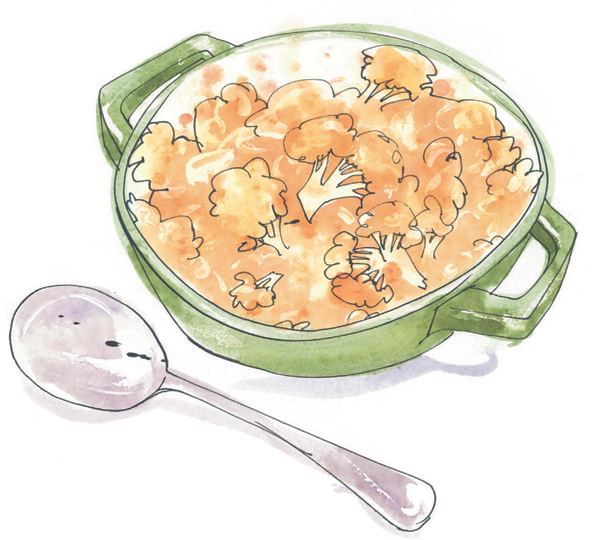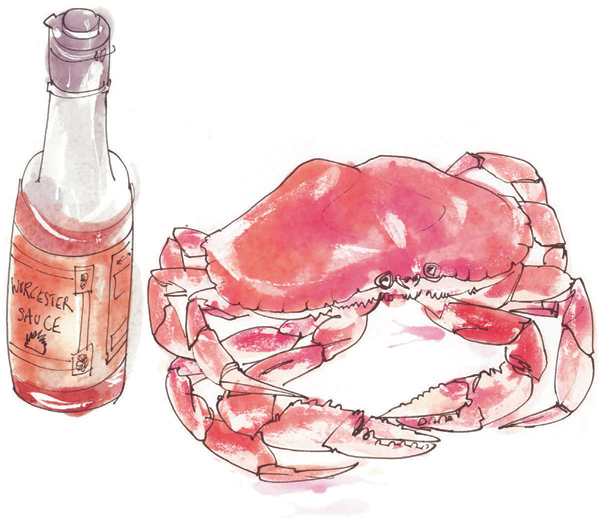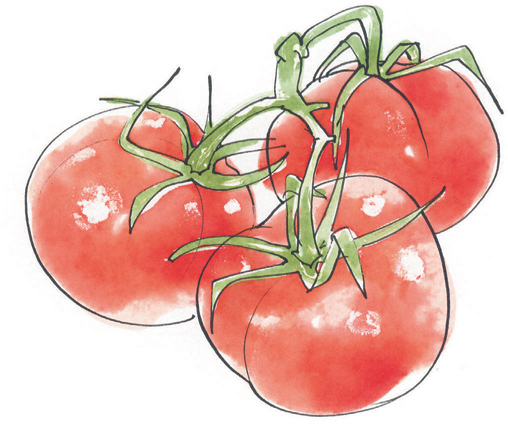
A dish for lovers of cheese. Serve as a main course, accompanied by some good bread and a salad.
Serves 4
1 cauliflower
30g butter
30g plain flour
450ml milk
250g mature cheddar, grated
FOR THE PARMESAN CRUMBLE
60g plain flour
60g butter, cut into small cubes
60g Parmesan, finely grated
Boil or steam the cauliflower until just cooked. Drain well, cut into pieces and put into an ovenproof serving dish.
Melt the butter in a large saucepan. Stir in the flour to make a roux, then add the milk a little at a time, stirring to make a smooth sauce. Simmer for a few minutes, then add the cheese and continue to cook, stirring all the time, until the cheese has melted. Pour over the cauliflower.
Preheat the oven to 210°C.
To make the Parmesan crumble, put the flour, butter and Parmesan in a food processor and pulse until the mixture resembles fine breadcrumbs, or rub together by hand. Scatter the mixture over the cauliflower cheese and then splash with a small amount of water – a couple of teaspoons, no more – off the ends of your fingers so that the mixture clumps a little on top. This helps to make the finished texture more interesting.
Put the dish on an oven tray and bake for about 15 minutes, until the sauce is bubbling and the crumble pale gold with darker spots. Serve immediately.
You can prepare the cauliflower cheese and the crumble topping in advance, but add the topping immediately before baking and cook at a slightly lower temperature for a little longer.

Devilled crab is the sort of dish that was enjoyed as a savoury: a piquant, rich mouthful served at the end of Edwardian dinners. It makes a good light lunch or supper, or a rich starter as part of a larger meal.
Serves 4
15g butter
30g shallot or spring onion, very finely chopped
200g prepared crabmeat (brown, or white and brown mixed)
1 teaspoon Worcestershire sauce
1 teaspoon whole grain mustard
½–1 teaspoon very finely chopped fresh red chilli
1 teaspoon grated fresh ginger
15g (2 heaped tablespoons) soft fresh white breadcrumbs
150ml double cream
FOR THE TOPPING
30g self-raising flour
15g butter, cut into small cubes
15g Parmesan, finely grated
30g soft fresh white breadcrumbs
Preheat the oven to 170°C.
Melt the butter in a small frying pan. Add the shallot or spring onion and soften gently without browning. Stir in all the other ingredients, except those for the topping, heat through gently and then divide between four ramekin dishes.
To make the topping, put all the ingredients in a bowl and rub together until you can no longer see the butter. Cover the crab mixture with the topping.
Bake for about 15 minutes or until the filling is piping hot and the top lightly browned and crisp. Leave to cool a little before serving.

Use mature cheddar for this recipe. Dried dill can be used if fresh is unobtainable, but reduce the amount from 1 tablespoon to a scant teaspoon.
Serves 4
30g butter
2 echalion (banana) shallots, finely chopped
About 200g spinach, washed and roughly chopped
30g plain flour
300ml milk
2 tablespoons crème fraîche
Finely grated zest and juice of 1 lemon
1 tablespoon chopped fresh dill
1 tablespoon chopped fresh parsley
Salt, pepper, and grated nutmeg
About 700g cod or hake fillet, cut into neat slices
FOR THE TOPPING
150g plain flour
50g dry white breadcrumbs
80g mature cheddar, finely grated
1 tablespoon chopped fresh dill
80g butter, melted and cooled but still liquid
Preheat the oven to 190°C.
Melt the butter in a large saucepan and cook the shallots gently until soft. Add the spinach and press it down with a wooden spoon until it wilts. Stir well, then stir in the flour. Add the milk and keep stirring over the heat until the mixture thickens. Cook for a little longer, then stir in the crème fraîche, lemon zest and juice, dill and parsley, and season to taste with salt, pepper and a little grated nutmeg. Put the fish into a gratin dish and pour the sauce over.
To make the topping, combine the flour, breadcrumbs, cheese and dill. Pour in the butter, stirring constantly to make a lumpy mixture. Scatter this over the sauce and fish. Bake for 25–30 minutes, until the topping is gold and the fish fully cooked. Serve immediately.


The contrast of crisp topping with soft filling is integral to the definition of a good crumble. As far as proportions are concerned, savoury crumbles tend to taste better with relatively thin, crunchy layers of crumble, closer to a gratin than a pudding. Vegetables, especially summer ones such as courgettes and tomatoes, and fish make lovely crumbles but the texture of meat, including mince, does harmonise especially well with the toppings.
Naturally, the first rule of making a savoury crumble topping is to omit the sugar. Cheese is the usual replacement for sweetness. Parmesan is very successful, relatively small amounts adding concentrated flavour; or try a good mature farmhouse cheddar, finely grated. For savoury fillings in which the vegetables have some natural sweetness, pecorino is a good choice.
Breadcrumbs are another good addition, enhancing the texture of savoury crumbles. Use them to replace a proportion of the flour. They can be soft crumbs from a fresh loaf, or dry ones made by baking stale bread in a low oven and crushing them. Japanese panko breadcrumbs, available from some supermarkets, are good too, but avoid the dried orange breadcrumbs sometimes used for breading ham or coating fish.
Spice flavours often seem to get lost among the butter and cheese. Mustard powder is worth trying, and cayenne pepper adds a piquant note. Some herbs work well, notably thyme, marjoram or dill. Seeds, especially toasted sesame, and nuts, such as almonds or pine nuts, scattered over the top to toast during cooking add flavour and will look attractive.
Good alone as a vegetarian lunch or light supper, or as a side dish with meat or fish.
Serves 4
500–600g floury potatoes, peeled
400–500g leeks (trimmed weight), washed and finely sliced
2 cloves garlic, finely sliced
300ml single cream
2 teaspoons cornflour
1 tablespoon finely chopped fresh tarragon
4 tablespoons finely chopped fresh parsley
Finely grated zest and juice of 1 lemon (preferably unwaxed)
Salt and pepper
FOR THE TOPPING
120g plain flour
60g butter, cut into cubes
60g blue Stilton
40g walnuts, roughly chopped
Preheat the oven to 200°C.
Cut the potatoes into roughly 1cm cubes. Put them into a saucepan, add water to just cover, bring to the boil and cook for about 8 minutes. Add the leeks and cook for another 2–3 minutes, then drain, reserving the cooking water and leaving the vegetables in the pan. Stir the sliced garlic into the mixture.
Mix the cream and cornflour together and stir into the vegetables. Heat gently, stirring well, until the cream comes to the boil. Thin with a little of the cooking water. Turn off the heat, add the tarragon, parsley and lemon zest, and season with salt, pepper and lemon juice. The mixture should be quite highly seasoned. Tip into a baking dish.
To make the topping, add a pinch of salt to the flour and rub in the butter. Crumble in the Stilton and stir in the walnuts. Spread over the vegetables and bake for 25–30 minutes or until the top is golden and the filling bubbling.
If you grow courgettes you’ll know that you can never have enough courgette recipes. This makes a good light lunch or supper, accompanied by salad, or as a side dish for fish.
Serves 3–4
450–500g courgettes, washed and trimmed
1 tablespoon olive oil
2 cloves garlic, crushed
1 onion, finely chopped
150g garlic and herb Boursin cheese
FOR THE TOPPING
80g Emmenthal cheese, coarsely grated
60g fresh white breadcrumbs
60g plain flour
Pinch of salt
40g butter, melted and cooled but still liquid
Preheat the oven to 170°C.
Halve the courgettes lengthways (or quarter them if they are large), then cut into slices about 5mm thick. Put the oil, courgettes, garlic and onion into a frying pan and cook gently, stirring frequently. Once the onions are translucent and the courgettes soft, add the Boursin, broken up into several pieces, stir well to mix, and then transfer the mixture to a baking dish.
To make the topping, put the Emmenthal, breadcrumbs, flour and salt into a bowl. Drizzle in the butter, stirring vigorously to make an uneven crumbly mixture. Spoon over the courgette mixture. Bake for 20–25 minutes and serve hot.

A huge range of vegetables were grown in the walled kitchen gardens of big houses. To get an idea of what was available, visit Tatton Park (Cheshire) to see a garden entirely planted with varieties developed in the nineteenth century. The highly accomplished chefs who worked in some of these houses almost certainly used them in gratins – cooked vegetables under a rich sauce, topped with breadcrumbs and cheese and grilled. Crumbles were unknown to them, but a cheese-rich savoury version is excellent with some vegetables.
Pumpkins and squash were grown mostly for entertainment value in the past, valued for their ornamental appearance rather than for eating. There was much more enthusiasm for the botanically related cucumbers and melons. For such crops, special ‘hot beds’ were constructed, such those still made at Acorn Bank (Cumbria), in which deep layers of decaying farmyard manure provide warmth for the roots of tender plants. Marrows have been widely grown in gardens since the nineteenth century, but their smaller relatives, courgettes, do not seem to have been popular until the 1960s.
Pumpkins and tomatoes both make good crumble bases. American-style pumpkin pies or muffins respond well to sweet crumble toppings. Slindon (Sussex) holds a mid-autumn pumpkin festival of these visually stunning fruit – for technically they are the fruit of the plant, complete with seeds.
Tomatoes, of course, are also fruit, even though usually treated as vegetables. They make interesting savoury crumbles, but they must be really good late-summer tomatoes with firm, beefy flesh, not pallid watery winter offerings. To taste a range and find out more, visit the Wimpole Tomato Festival where the fabulous kitchen garden of this great house in Cambridgeshire celebrates them every September; or try Knightshayes in Devon, to view their collection of over 100 heritage varieties.
Make this with late summer tomatoes, choosing large, firm-fleshed varieties such as coeur de boeuf or plum tomatoes, or visit Wimpole Tomato Festival (Cambridgeshire) for more inspiration.
Serves 4
2 aubergines
6–8 tablespoons olive oil
About 800g tomatoes
2 echalion (banana) shallots, chopped
1 clove garlic, crushed
½ teaspoon salt
1 teaspoon muscovado sugar
Small bunch basil, leaves only
Small bunch parsley, leaves only
FOR THE TOPPING
80g plain flour
80g fresh white breadcrumbs
40g mature pecorino cheese, finely grated
80g butter, melted and cooled but still liquid
2 tablespoons pine nuts
Preheat the oven to 180°C.
Cut the aubergines into slices about 1cm thick and brush both sides lightly with olive oil. Grill under a high heat for about 3–5 minutes on each side, or until beginning to soften, then leave to cool.
Add a tablespoon of the oil to a frying pan and cook the shallots and garlic gently for about 5 minutes. Drop the tomatoes in boiling water for 15 seconds, remove and peel off the skins. Slice thickly.
Blend the remaining olive oil with the salt, sugar, basil and parsley to make a thick paste.
Put half of the shallot mixture into a baking dish, then add half the aubergine slices and half of the tomatoes. Repeat. Pour the herb and oil mixture over.
To make the topping, mix the flour, breadcrumbs and cheese, then stir in the butter to give a crumbly texture, and spoon over the vegetables. Scatter the pine nuts over. Bake for 20–30 minutes, until the top is golden and the filling bubbling.
Eat warm or just cooled, as a light lunch or supper, or as an accompaniment to grilled meat.
